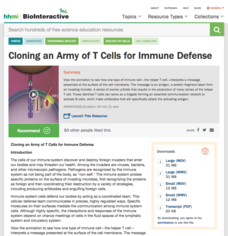Socratica
Chemistry: Molar Mass
Molar mass, gram molecular mass, and gram formula mass essentially mean the same thing. The brief video, part of the Socratica "Chemistry Lessons" playlist, explains how to solve these problems. It walks through the required tools, the...
Curated OER
Oxidation and Reduction Review From Biological Point-of-View
Review of reduction and oxidation opens this video. It really helps stimulate understanding of these biochemistry topics. By explaining the loss or gain of electrons, Salman Khan is able to clarify the concept of respiration processes.
TED-Ed
Are You a Body with a Mind or a Mind with a Body?
Do you think, therefore you are? Or are you therefore you think? Are the mind and the body one or separate? Introduce young philosophers (and science fiction fans) to the mind/body problem with a video that is sure to fascinate viewers.
TED-Ed
What Is Fat?
An animated fat molecule explains how some fats are beneficial and some are harmful. He describes triglyceride molecules and how the chemical bonding or overall shape determines the health value of each individual type of fat. This...
PBS
The RNA Enigma
Folding a fitted sheet seems impossible, but folding RNA seems like a game. Viewers learn how they can help scientists prevent or cure diseases. It emphasizes the need for human help because computers struggle with these puzzles.
Howard Hughes Medical Institute
Prialt Blocks Motor Synapse in Fish
Have you ever wondered how to paralyze a fish? The cone snail produces venom that works, but what happens at a molecular level? A calcium channel blocker prevents muscle movement, enabling the slow-moving snail to catch faster, larger...
TED-Ed
What Is the Biggest Single-Celled Organism?
Meet Caulerpa taxifolia, believed to be the largest single-celled organism in the world. How does it work and where is it found? Learn all about this invasive algae and why it is so successful.
Howard Hughes Medical Institute
Chargaff's Ratio
How do we know the structure of DNA? Learn about Chargaff's rule and how scientists first discovered the structure of DNA. Using an informative video, young scientists identify how the arrangement of complementary nitrogen bases affects...
Education Development Center
What's Cooking? Carbohydrates
Chef Jamika is at it again, highlighting math and science in her cooking demonstrations. In this episode, ratios and fractions are introduced within the main topic of carbohydrates and the direction for making succotash! The general...
Socratica
What Is Biochemistry?
Watch as chemistry comes alive! Socratica's biology playlist kicks off with a simple video detailing the principle components of biochemistry. Content includes carbohydrates, proteins, and nucleic acids. The narrator describes each class...
Howard Hughes Medical Institute
Lactose Digestion in Infants
Milk meets every single nutritional need for a baby in the first six months of life. Observe how an infant's small intestine breaks milk lactose down into a usable form of nutrition. With the help of an animation, viewers see the process...
PBS
How Two Microbes Changed History
Where would we be without bacteria? As it turns out, we owe them everything! Introduce young biologists to endosymbiotic theory using an amazing video from an extensive biology playlist. Scholars discover the bacteria that may be...
Crash Course
Water - Liquid Awesome
If H2O is water and H2O2 is hydrogen peroxide, what is H2O4? Drinking, bathing, and cooking among others. Viewers of a short video explore water through its molecular structure, its ability to stick to itself through adhesion (cohesion...
Socratica
Chemistry: Ionic Bonds vs Covalent Bonds (Which is Stronger?)
Both ionic and covalent bonds present as strong bonds, but which is stronger? Socratica presents a video from its chemistry playlist that attempts to answer this question. It addresses how strength is measured and the range of strengths...
Stated Clearly
What is DNA and How Does it Work?
Explaining exactly how DNA works to provide genetic information is a complex topic, but it is presented in a clear and engaging way through a five-minute video. Have learners try to explain how DNA works before watching the video, then...
Curated OER
STEMbite: Diffusion
A biology or physical science class would benefit from viewing this video on diffusion and molecular motion. Mr. Vanden Heuvel plays with food coloring in drinking glasses, showing that the faster the water molecules are moving due to...
Curated OER
Cancer
It is fascinating to learn about apoptosis and the fact that cells are able to destroy themselves without any external influence. Sal creates interest in the huge number of cells and the complexity of the human body. The likelihood of a...
Howard Hughes Medical Institute
Cloning an Army of T Cells for Immune Defense
How do bodies fight infections and illnesses? An animation of the way T cells clone to fight an infection provides many details. The resource also provides an excellent written introduction and ideas for how to ensure pupils understand...
Curated OER
Introduction to Heredity
Young scientists generally love to learn how certain traits can be explained by a direct combination of alleles from their parents. Here, they are able to examine how a phenotype is often expressed as a result of one allele being...
Curated OER
Anatomy of a Muscle Cell
Previous videos have dealt with the proteins that produce mechanical motion and how nerves stimulate contraction. But this presentation explains on a gross anatomical scale, how skeletal muscle is structured.
Socratica
Chemistry: What Is a Metal? (Metallic Bonds)
Metals offer unique properties thanks to the structure of their valence electrons. The Socratica chemistry playlist includes this video explaining what a metal is and the properties of metals. It focuses on their structures, features,...
Socratica
Empirical Formula
With empirical formulas, it's all about keeping it simple! Introduce the concept of empirical formula to your chemistry scholars through a detailed video from Socratica's Chemistry Lessons series. The resource uses visual cues,...
Socratica
Chemistry: What Is an Ionic Bond?
Teach your class all they want to know about ionic bonds. An engaging video, part of the Socratica "Chemistry Lessons" playlist, explains what ionic bonds are and how they form. It describes multiple examples of ionic bonds and...
Socratica
Chemistry: What Is a Covalent Bond? (Polar and Nonpolar)
When it comes to covalent bonding, sharing is caring! As part of the Socratica chemistry playlist, a useful video explains the definition of covalent bonding. Then, it works through examples of single bonding, double bonding, polar...
Other popular searches
- Cell and Molecular Biology
- History of Molecular Biology
- Molecular Biology Software
- Molecular Biology Models
- Molecular Biology Organic
- Evolutionary Molecular Biology
- Molecular Biology of Gene
- Cellular Molecular Biology
- Molecular Biology Vido
- Molecular Biology Vi Do
- Cellular and Molecular Biology
- Molecular Biology Video

























